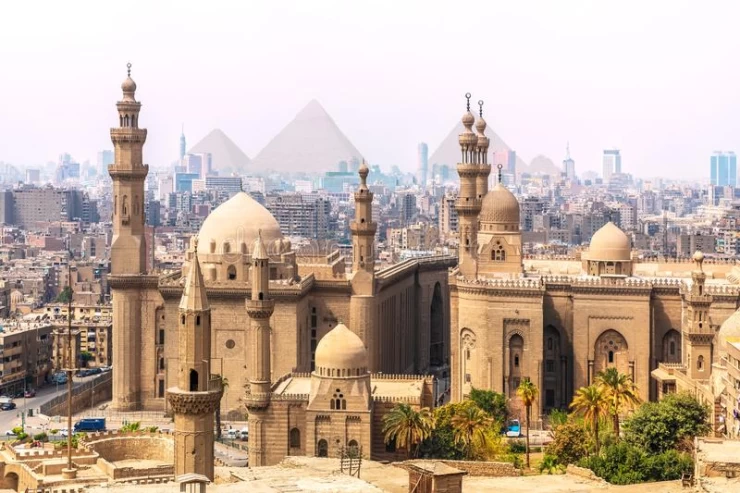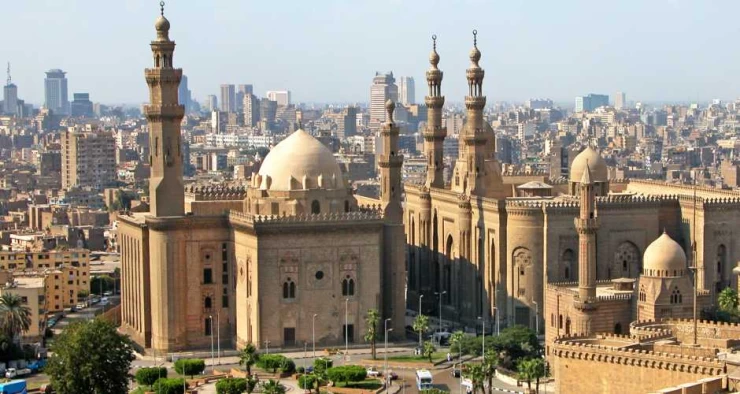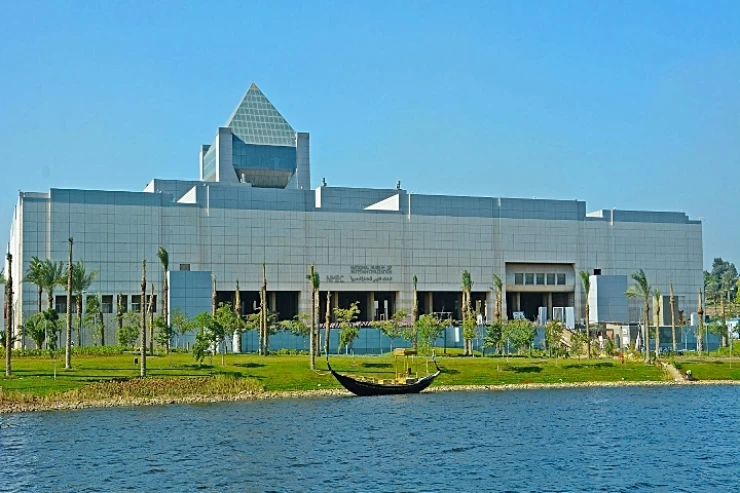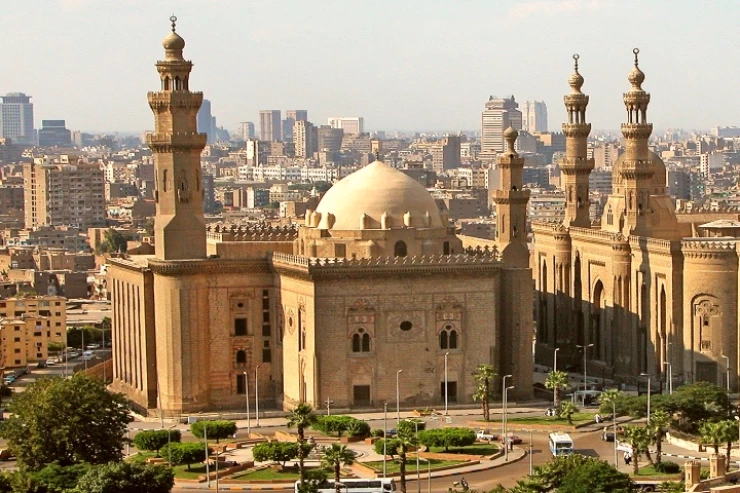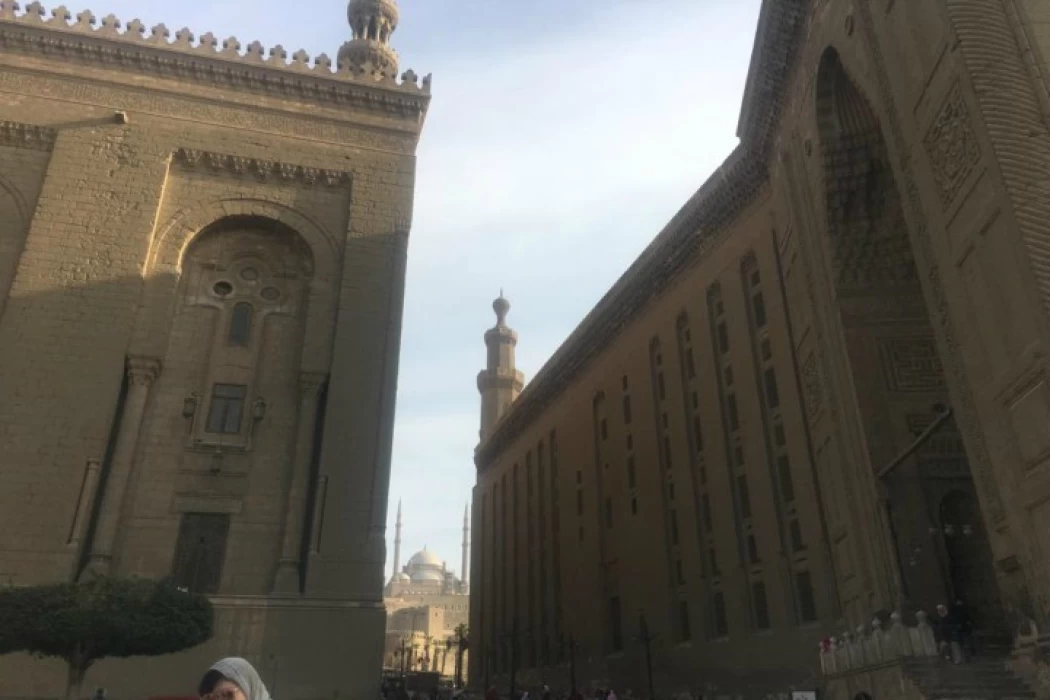
La Mezquita de Sultan Hassan

El Complejo Sultan Hassan combinó la magnitud del edificio, la precisión de la industria y la diversidad de la decoración, por lo que merecía ser descrito como una obra maestra arquitectónica y un orgullo del antiguo arte islámico. Se dice sobre la mezquita monumental de "Gomar" en un libro que describe Egipto: "Es uno de los edificios más bellos de El Cairo y el Islam, debido a su alta cúpula, la altura de su minarete, el hueso de su amplitud y el lujo y abundancia de su decoración. Al-Maqrizi lo describió como "uno de los templos musulmanes que no se conoce en el Islam. Esto imita a la mezquita".
El edificio más grande de El Cairo islámico además de la puerta más alta, especialmente entre todas las mezquitas y escuelas. el complejo consta de Musque, escuela y pernoctación para estudiantes y profesores, cuenta con cuatro escuelas para la enseñanza de los cuatro ritos sunitas

La Mezquita del Sultán Hassan se cuenta como una de las mezquitas más completas para hacer en El Cairo o tal vez en todo el mundo y especialmente en El Cairo islámico, mide 150 m de largo y cubre un área de 7,906 metros cuadrados. Sus muros se elevan a 36 m de altura y su minarete más alto mide 68 m. Los visitantes pueden ingresar al complejo a través de un portal alto que es una obra de arte excepcional. Un pasillo oscuro y de techos relativamente bajos conduce al resplandeciente brillo, un patio abierto estándar de planta cruciforme. Los centros del patio en una fuente de abluciones abovedada, que probablemente fue una adición otomana. Elevándose en cuatro lados del patio hay iwans redondos (salas de estar), mantenidos por cadenas de lámparas colgantes y bordes rojos y negros. El famoso sultán mameluco Hassan que fundó (La mezquita del sultán Hassan), es hijo del gran sultán mameluco Al-Nasser Mohamed Ibn kalawoun. Gobernó dos reinados interrumpidos, la primera vez en 1347, cuando tenía 13 años, para ser destronado por los demás príncipes y generales mamelucos. La segunda vez fue en 1356 d.c., y antes de que tuviera tiempo de poner fin al poder de los príncipes y altos funcionarios, hicieron una revolución contra él. Dijo que escapó de la ciudadela de Salah Eldin, pero fue encontrado y encarcelado, para que nunca más se lo volviera a ver. La mayoría aparentemente fue asesinado 16 años después de su ascensión al trono. Dejó 10 hijos y 6 hijas atrás.
La mezquita se construyó sobre el sistema de escuelas con planificación ortogonal, y cada escuela se considera una mezquita pequeña, y cada una de ellas está dedicada a enseñar una de las cuatro escuelas islámicas, "Shafi'i, Maliki, Hanbali y Hanafi", la más grande de estas escuelas Hanafi. Veinte postulantes y tres ayudantes docentes, y a cada uno de ellos se le asignó un salario acorde a su puesto de trabajo. Nombró a un maestro para interpretar el Corán y con él a treinta alumnos. También nombró a un maestro para el hadiz del Profeta, y se le asignó un salario de 300 dirhams.
Como es típico en el estilo de planificación arquitectónica mameluca, la qibla iwan es la más grande de las 4 iwan dentro de la mezquita. Que está hecho de mármol y conocido como el banco del repetidor, ubicado frente a la qibla iwan es (Dekkat Al-Mouballegh), elevado sobre 8 pilares y 3 pilares. Detrás del mihrab, hay 2 puertas abiertas en la pared de Quibla que conducen a la cúpula de un mausoleo donde se rumorea que está enterrado el sultán. El techo del Mausoleo es de 21 metros cuadrados y su decoración es similar a la de la qibla iwan.

Cerca de la Mezquita del Sultán Hassan puedes visitar:
La mezquita de Ibn Tulun.
La ciudadela de Salah Eldin.
Mezquita de Al Azhar.
Explore el Tour de El Cairo Islámico si está planeando algún viaje a Egipto o de nuestra variedad de tours desde El Cairo.
The Mosque and Madrasa of Sultan Hassan is one of the most stunning examples of Islamic architecture in Cairo, and it is not surprising that the mosque is situated around the Citadel of Saladin, in the interior of Old Cairo. The complex embodies the epic proportions of Mamluk architecture and is famous for its great scale, beautiful intricate patterns and detail, and its past. Visitors around the globe make pilgrimages to the beauty and history of this architectural and cultural masterpiece, which is the pride of the Mamluk Sultanate.
Historical Overview
This mosque and khanqah compound construction was commissioned by Sultan Hassan bin al-Nasir Muhammad around the year 1356 AD, and he intended it to be more than a mosque as it would serve as a madrasa (school of study) for the four major Sunni sects of Islam: Hanafi, Maliki, Shafi’i, and Hanbali. The construction of the tomb was commenced in the 1356 Christian era, which took around seven years to complete. It was also used as a place to learn and worship. But the bad part was that, alas, within a matter of hours, after the Sultan ordered his last and grandest design, the Sultan was assassinated, thus enhancing the myth.
The complex was built in one of the cities that over the years have suffered many interruptions within its history, internally due to earthquakes as well as military sieges, some of which rendered its architectural design adversely. But it has remained a significant symbol of Mamluk rule and devotion and continues to be open for worship and visitors.
While the Sultan Hassan Complex has much to offer, its enormous scale is undoubtedly the most impressive feature. The main entry that is just under 26 meters in height leads to a courtyard that is surrounded by walls that rise to a height of 36 meters. The entire mosque covered about 7900 square meters, making it one of the biggest mosques in the globe. The building’s symmetrical stone elevation and rich use of geometrical decor and ornamental monuments are typical Mamluk architectural designs.
Also, within the mosque’s interior—except for the one iwab—which houses four schools of Sunni Islam and a large central courtyard, which is encircled by four iwans. The Iwan located at the center pointing to Mecca is enhanced with elaborate stucco work and marbles, as well as a decorated'mihrab.'.’ The courtyard is also properly arranged with the help of vertical members in the form of columns. The guests will also admire the lofty walls of the space, which have curved ceilings, creating an almost ethereal feeling in the room.
The organization, which is popularly referred to as the madrasa or Islamic institution in its primary sense, was one of the objects of the original vision of the complex. So all four iwans also served as classrooms for one of the Sunni judicial schools. This period also explains the presence of such illustrious personages in the inner chambers surrounded by students hailing from every corner of the Muslim world due to its esteem as the pinnacle of education.
The institution committed to the good health of its students as well. This implied that in addition to regular classes being offered, nutrition, dormitories, and a reading room were also provided to the students. The madrasah is covered by Koranic verses placed on the walls as ornaments and motivational resources for the student scholars who were within its confines.
Equally intriguing is the tomb of Sultan Hassan, which is another distinguishing element of the Sultan Hassan Complex. The tomb is in the back of the main prayer room and is said to be one of the best preserved examples of Mumluk burial architecture. The dome is surmounted by a giant dome that is 21 meters in height and is embellished with beautiful arabesques and inscriptions. Based within the mausoleum, there lies the sarcophagus of Sultan Hassan, encased in walls of marble embedded with Mamluk-style masterpieces.
Interestingly, Sultan Hassan’s body was never interred in this mausoleum, as he was killed before the complex was completed, and his remains were buried elsewhere. Nevertheless, the mausoleum remains a symbolic resting place and is a beautiful tribute to his memory.
The Sultan Hassan Complex is a superlative work of Islamic art and architecture, with every detail thoughtfully designed and executed to fit the Mamluk style. The walls and ceilings are clad in arabesques, geometric designs, calligraphy, and other typical components of Islamic art. The fishtail and stucco carving works, embellished on the surfaces, unequivocally demonstrate the exceptional artistry that went into building the entire complex.
Among the dominant artistic aspects, one cannot miss the beautiful wooden mashrabiya, which has elaborate floral and geometric carvings in it, encouraging the eye to explore its design. In addition to enhancing the beauty of the complex, these screens also provide ventilation as well as privacy. Another thing that adds beauty to the mosque is its mihrab, which is made of marble and embellished with decorative panels and mosaics that instill a certain level of spirituality.







